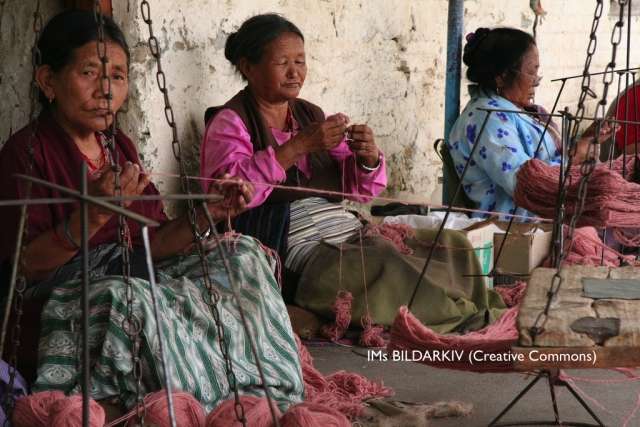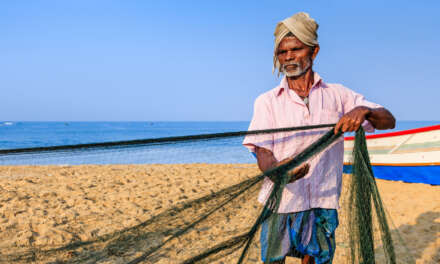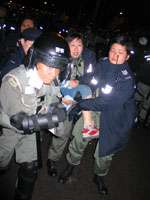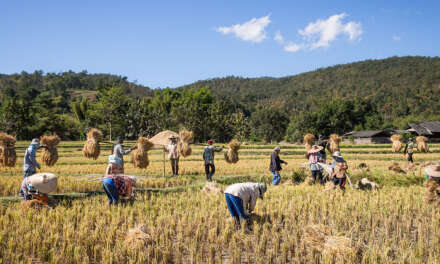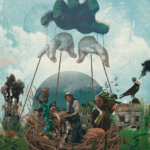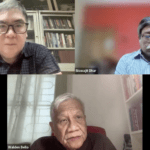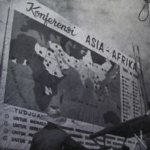When the WTO was created, the trade negotiations were mainly decided by the U.S., Europe, Japan and Canada, and their decisions were imposed on the rest of developing countries. At that time, China and Russia were not members of the WTO. Trade negotiations then, in a way, reflected the share that these countries had in global trade. The “big four” accounted for 68 percent of total exports in 1994. The BRICS (Brazil, Russia, India, China and South Africa)—that didn’t exist as an alliance then—accounted for only 6.5 percent of total exports.
The emergence of and disparities between old and new players
In its 18 years of existence, the situation of the WTO has changed. China and recently Russia have become members of the WTO. Today, the old “big four” have reduced their share to 49.9 percent of global exports of goods while the BRICS countries now represent 17.4 percent of the global market of commodities.

The weight of the BRICS is even larger if we take into account that around 70 percent of Europe’s trade is trade within the European Union.
Up until 2011, the BRICS had a very important increase in trade but in 2012, their growth began to slow down, with the situation getting worse in 2013. Brazil, Russia, India and South Africa are now mainly exporters of raw materials and primary products. China is a different story and has become the top exporter of goods in the world. When it comes to “commodities with value added” the new elephant in the room is definitely China—more than the BRICS taken as a group-while the old “big four” are on the decline.
Competition in a slowdown context
During the last 18 years of the WTO, it is not only the relation between players that has changed but also the context of global trade and investment. Up until 2007, global trade had grown three times from the levels of 1994, but since the beginning of the crisis, the rate of global trade growth has paused. Also, global capital flows are now only one-third of the $11 trillion reached in 2007.
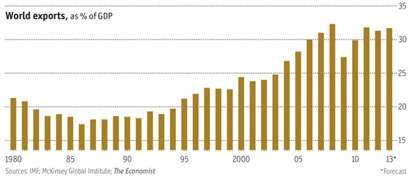
Some analysts believe that this slow down is temporary. Others, like us, think that this will be the new normal. Almost everybody agrees that global trade will likely remain sluggish for years. In this context, what are the strategies of the different players?
Different strategies for their corporations
The trade agenda agreed by BRICS in 2012 focused on: 1) promoting “intra-BRICS trade and investment” of “high value-added products;” 2) creation of a “New Development Bank of the BRICS” for “infrastructure and sustainable development projects in BRICS and other emerging economies and developing countries,” and 3) the establishment of a “Contingent Reserve Arrangement (CRA) amongst BRICS countries” with an initial size of US$ 100 billion to “help BRICS countries forestall short-term liquidity pressures, provide mutual support and further strengthen financial stability.”
The trade and investment expansion strategy of the BRICS is mainly through the allocation of public resources in infrastructure, extractive industries and other projects in BRICS and developing countries in order to create demand for their own corporations and to gain more access to natural resources.
The strategy of the old “big four” is to push for more trade liberalization through free trade negotiations like the TPP (TransPacific Partnership), TAFTA (TransAtlantic Free Trade Area) and other FTAs to counter-balance the trade expansion of China and set up a new standard of deeper trade liberalization for all countries.
China combines both strategies and has negotiated FTAs with many of the same partners that have FTAs with the EU and the U.S. China mixes a “controlled,” “gated,” “limited” free trade strategy with state intervention policies to expand their own corporations around the world.
In a shrinking context, the competition gets worse, but behind closed doors, many of the State Owned Enterprises and the private Transnational Corporations are doing business together, all over the world. The concentration of capital is increasing as well as inequality. The losers of these different strategies to promote their corporations are the people and nature.
Implications for the WTO
When it comes to the WTO, both BRICS and the old “big four” want some kind of outcome in the 9th Ministerial Conference in Bali to give a positive signal to the sluggish markets. All of them have agreed to leave aside the “single undertaking” deal of the Doha Round to avoid a stalemate. All of them have brought from the dead one element of the rejected “Singapore Issues” in 2003: Trade Facilitation.
The United States is pushing for a more ambitious trade facilitation agreement. India is willing to accept just a peace clause for the implementation of subsidies for small farmers that go beyond the current agreed levels in the WTO. Brazil, which now leads the WTO, wants to show that they are able to move the stalled negotiations. “There is a message for the WTO,” said the new Brazilian Director General of the WTO, “the past two years of sluggish trade growth reinforce the need to make progress in the multilateral negotiations.”
In synthesis there is a new environment that can lead to the unlocking of the stalemate of the WTO. If this happens, the most dangerous thing will be what comes after the Bali package. The “old four” have a strong offensive strategy that goes from bringing the remaining Singapore Issues (investment, government procurement and competition), including new issues like environmental services, to the multilateral level many of their “gains” in FTA negotiations. The BRICS have a more defensive strategy with one main offensive issue in relation to the agriculture subsidies of the developed countries, but at this stage of the economic crisis of the developed countries they see that it is not possible to move this forward.
Nothing has yet been said about the WTO negotiations. There are disagreements in relation to the flexibilities for developing countries in Trade Facilitation; the length of the peace clause for “food security” is in debate and nothing is clear yet in relation to the day after a Bali package.
The WTO moves very slowly but as it does it involves almost all countries expanding liberalization to the entire globe at the expense of humanity and nature.

